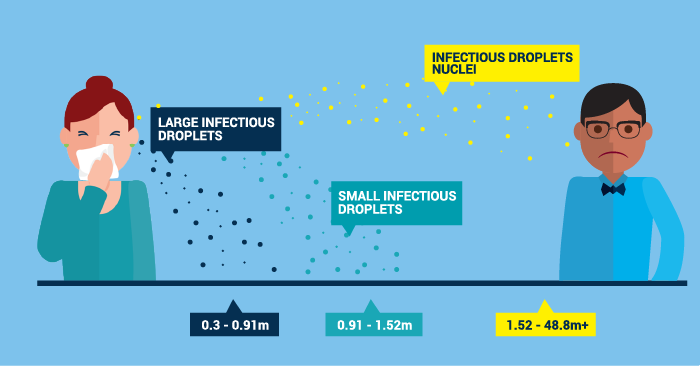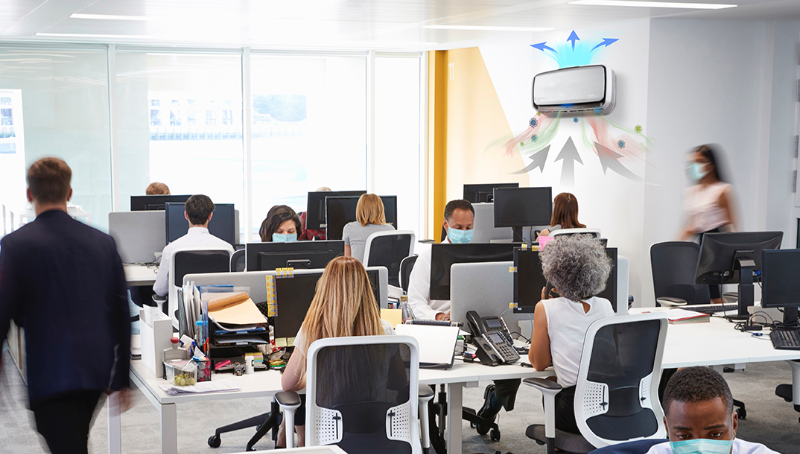In today’s health-conscious world, we wipe down surfaces, sanitise our hands and go to great lengths to avoid germs and viruses.
But do our efforts really work? Are fewer people getting colds, flu and other viral or bacterial diseases?
Unfortunately, no.
In fact, the last few flu seasons have been some of the most testing ever for the NHS. And then, of course, we’ve seen the ravages of the deadly Covid-19 pandemic bring a whole new threat to our doorstep.
Colds, flu and similar viruses affect 15 million people in the UK every year, and it’s estimated that 24.6 million working days are lost to Sick Building Syndrome, which is costing the British economy around £32 billion every year in lost productivity.*
So, despite all the efforts we make to prevent the spread of germs and viruses, why do we continue to see high levels of sickness from flu-related illnesses?
Part of the answer is that whilst we are programmed to clean surfaces and wash our hands, we tend to overlook something that’s more influential in causing illness: the air we breathe!
Whilst germs, viruses and bacteria do eventually land on surfaces, they first travel in the air, and that's when we have the greatest chance of inhaling or even swallowing them and becoming sick.
 Air is infected by individuals when they sneeze, cough, talk - or simply breathe. A single sneeze can launch a cloud of infectious droplets. The smallest and most dangerous are called droplet nuclei. These tiny terrors stay airborne the longest and travel the furthest. When inhaled, their microscopic size often allows them to bypass our body's natural defences and penetrate deep into the lower respiratory system, where it can take just one to three airborne viruses to cause an infection.
Air is infected by individuals when they sneeze, cough, talk - or simply breathe. A single sneeze can launch a cloud of infectious droplets. The smallest and most dangerous are called droplet nuclei. These tiny terrors stay airborne the longest and travel the furthest. When inhaled, their microscopic size often allows them to bypass our body's natural defences and penetrate deep into the lower respiratory system, where it can take just one to three airborne viruses to cause an infection.
Toilet flushes are also notorious for launching germs. Studies confirm that a single flush can release millions of viruses and bacteria to contaminate the air for unsuspecting occupants to inhale.
Ventilation systems can further spread infectious airborne contaminants by pulling pollutants through a room and distributing them to other areas of the building.
This all means that the air around us can actually harbour more threats to our health and wellbeing than the surfaces that surround us. So, there is a definite need to clean the air of viruses, bacteria, pollen, dust, dust mites, pet dander, mould, odour and volatile organic compounds, which surface cleaning does little to address.
A complete hygiene solution should consist of three essential components –
- Washing your hands,
- Sanitising surfaces, and
- Cleaning the air for protection against person-to-person virus transmission.
The importance of HEPA filters
The Covid-19 Ventilation Guidance - published by CIBSE (Chartered Institute of Building Services Engineers) - highlights the importance of using air cleaners with HEPA filters to effectively remove particles from the air.

As part of our Post-Covid services to help companies prepare their offices for when workers return, we're recommending that our clients consider air purification to clean the air you share.
We're working with AeraMax Professional® commercial grade air purifiers to help clients that don't have already have HEPA filters in their air conditioning systems gain access to the same technology.
The AeraMax Professional HEPA air purifier utilises a unique four-stage filtering system to remove 99.9% of airborne contaminants as small as 0.3 microns, including: viruses, germs, odours, allergens and other pollutants.
By adhering to simple and cost-effective methods of maintaining clean and healthy air, such as air purification, you can have a profoundly positive effect on the welfare of your people and help create a healthy office environment.
To find out more about how you can purify the air in your office, please get in touch.








